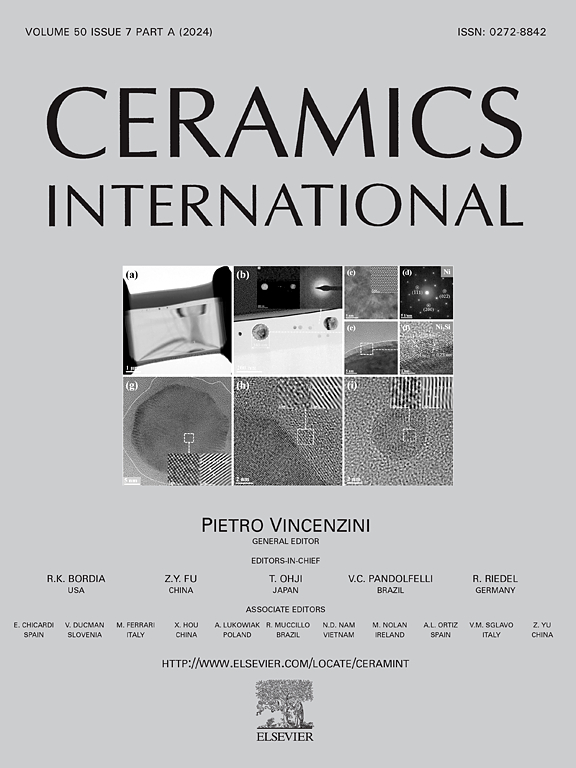多功能杂交红色荧光纳米颜料:光致发光、光催化和先进的法医应用
IF 5.6
2区 材料科学
Q1 MATERIALS SCIENCE, CERAMICS
引用次数: 0
摘要
近年来,研究主要集中在了解镧系离子掺杂荧光粉的局部结构、缺陷工程和激发依赖光谱。本文采用简单的燃烧方法合成了强红光BaZrO3:Eu3+纳米粒子。对所获得的荧光纳米颜料进行了结构、形态、光致发光、光催化和高级法医研究。粉末的x射线衍射(PXRD)结果显示为简单的立方结构。扫描电镜(SEM)显微图显示出六边形棒状结构。此外,通过透射电子显微镜(TEM)图像估计其粒径约为45 nm。通过激发和发射图对荧光纳米素的发光行为进行了检测。在396 nm激发波长下,Eu3+离子的四个显著峰分别位于5D0→7F0 (578 nm)、5D0→7F1 (591 nm)、5D0→7F2 (601 nm)、5D0→F3 (612 nm)。进行了荧光寿命衰减测量,发现平均寿命26.74 ns。通过色度色图、内量子效率(IQE)和颜色纯度来评价荧光纳米颜料的效率。量子效率和色纯度分别为76%和94%。研究了所合成的纳米颜料具有优异的光催化性能。结果表明,所制备的粉末可成功地用于污水的除染。获得的纳米粉末也评估了其先进的法医应用。该粉末在无背景干扰的情况下,在多种基底表面表现出良好的潜在指纹可视化效果。鉴定并报告了1、2、3型指纹脊细节。记录的所有结果表明,合成的纳米粉末基本上可以用于污染水中的染料去除,白光LED制造中的红色成分以及先进的司法应用。本文章由计算机程序翻译,如有差异,请以英文原文为准。

Multifunctional hybrid red fluorescent nanopigments: Photoluminescence, photocatalytic and advanced forensic applications
In recent years, research was mostly centred on understanding local structure, defect engineering and excitation-dependent spectroscopy in lanthanide ions doped phosphors. In this report, a simple combustion method was utilized to synthesize the intense red emitting BaZrO3:Eu3+ nanopigments. The obtained fluorescent nanopigments were examined for their structural, morphological, photoluminescence, photocatalytic and advanced forensic studies. The powder X-ray diffraction (PXRD) outcomes exhibited simple cubic structure. The scanning electron microscopy (SEM) micrographs revealed the hexagonal rod-like structures. Further, the particle size was estimated using Transmission electron microscope (TEM) images and it was observed to be around 45 nm. The fluorescence nanopigments were checked for their luminescence behaviours by means of excitation and emission plots. The four significant peaks of Eu3+ ions located at 5D0→7F0 (578 nm), 5D0→7F1 (591 nm), 5D0→ 7F2 (601 nm), 5D0→F3 (612 nm) were observed under 396 nm excitation wavelength. The fluorescence lifetime decay measurements were carried and found average lifetime 26.74 ns. The efficiency of the fluorescent nanopigments was evaluated by chromaticity color diagrams as well as internal quantum efficiency (IQE) and color purity. The quantum efficacy and color purity values were found to be 76 % and 94 % respectively. The synthesized nanopigments were also studied for their excellent photocatalytic properties. The results indicated that, the present powders can be successfully used as dye removal in the treatment of polluted water. The obtained nanopowders were also evaluated for their advanced forensic applications. The powders exhibited excellent visualization of latent fingerprints on several substrate surfaces without any background interference. The fingerprint ridge details such as Type 1, 2, 3 were identified and reported. The recorded all results demonstrated that, the synthesized nanopowders can be essentially utilized as dye removal in the polluted water, red component in white LED fabrication and also in advanced forensic applications.
求助全文
通过发布文献求助,成功后即可免费获取论文全文。
去求助
来源期刊

Ceramics International
工程技术-材料科学:硅酸盐
CiteScore
9.40
自引率
15.40%
发文量
4558
审稿时长
25 days
期刊介绍:
Ceramics International covers the science of advanced ceramic materials. The journal encourages contributions that demonstrate how an understanding of the basic chemical and physical phenomena may direct materials design and stimulate ideas for new or improved processing techniques, in order to obtain materials with desired structural features and properties.
Ceramics International covers oxide and non-oxide ceramics, functional glasses, glass ceramics, amorphous inorganic non-metallic materials (and their combinations with metal and organic materials), in the form of particulates, dense or porous bodies, thin/thick films and laminated, graded and composite structures. Process related topics such as ceramic-ceramic joints or joining ceramics with dissimilar materials, as well as surface finishing and conditioning are also covered. Besides traditional processing techniques, manufacturing routes of interest include innovative procedures benefiting from externally applied stresses, electromagnetic fields and energetic beams, as well as top-down and self-assembly nanotechnology approaches. In addition, the journal welcomes submissions on bio-inspired and bio-enabled materials designs, experimentally validated multi scale modelling and simulation for materials design, and the use of the most advanced chemical and physical characterization techniques of structure, properties and behaviour.
Technologically relevant low-dimensional systems are a particular focus of Ceramics International. These include 0, 1 and 2-D nanomaterials (also covering CNTs, graphene and related materials, and diamond-like carbons), their nanocomposites, as well as nano-hybrids and hierarchical multifunctional nanostructures that might integrate molecular, biological and electronic components.
 求助内容:
求助内容: 应助结果提醒方式:
应助结果提醒方式:


